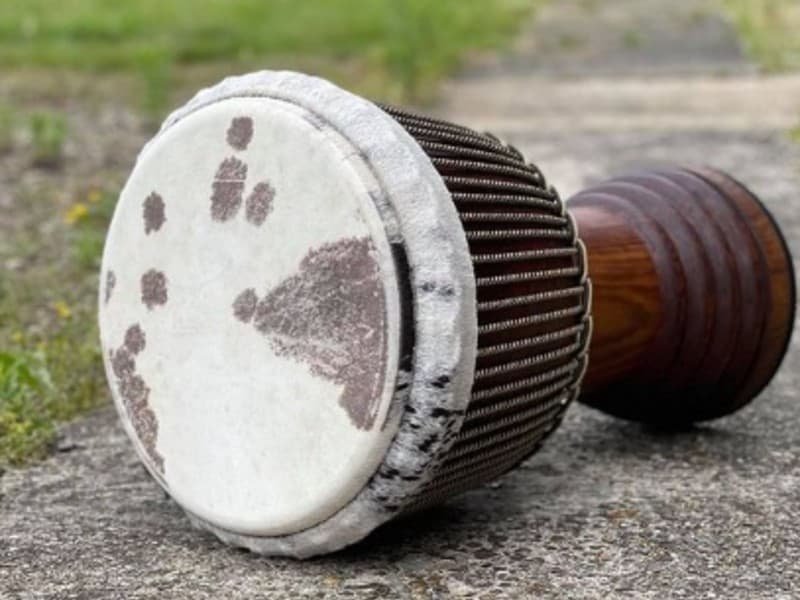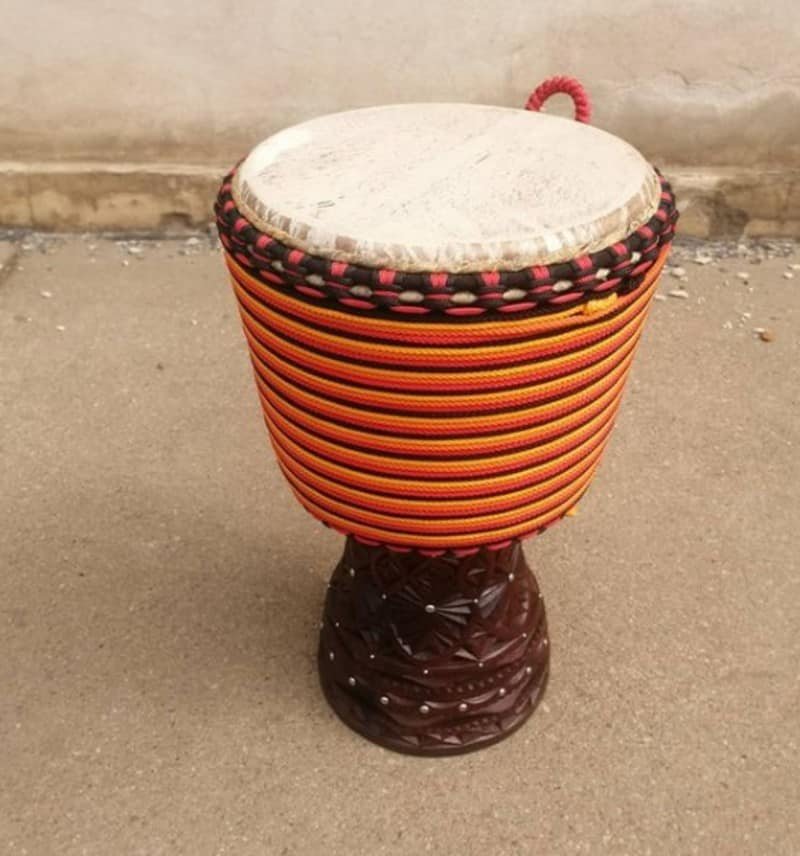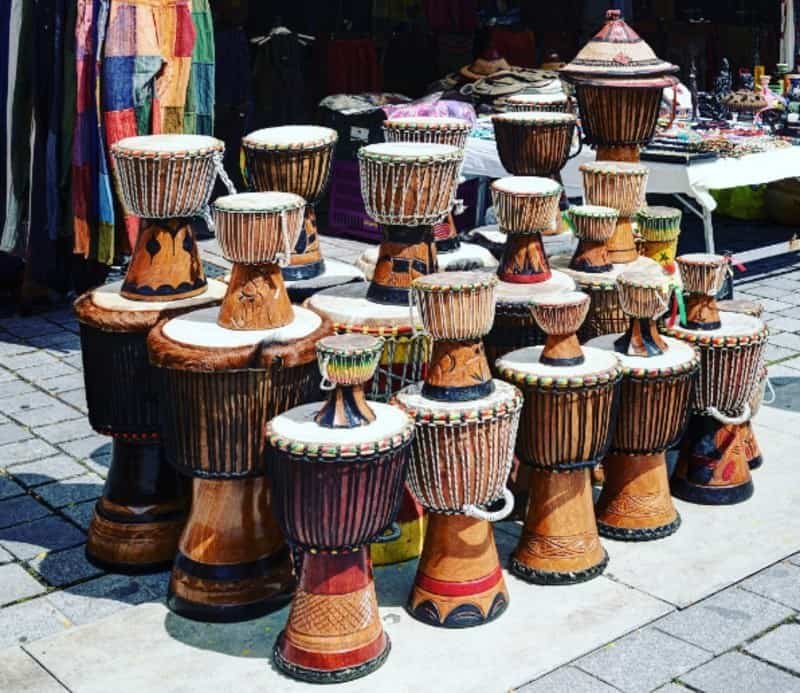How to Choose Djembe Drum? – Pick the One That Won’t Disappoint You

A djembe is a cup-shaped West African drum with an open narrow bottom and a wide top, over which a leather membrane is stretched. The market is full of plastic models, and the leather membrane has been replaced with synthetic fiber. As you can imagine, such instruments are far from authentic and might not have that unique sound. In this article, I will tell you how to choose the djembe drum, what to look for, and which pitfalls there might be. All this is very important if you are looking for a musical instrument and not just an exotic interior decoration.
How to Choose Your Very Own Djembe Drum?
Contents
In this section, I will outline several factors that are especially important in choosing such drums. However, given the sacred importance of the instrument and its impact on health, your feelings are of paramount importance. That is, always keep my manual in mind but be guided by whether you like this or that djembe or not.
Shell
Ideally, the drum should be carved from a single piece of wood. For some novice musicians, in its appearance, it can resemble another African instrument called ashiko, but you should not confuse them. The traditional djembe is made of very durable wood such as Ironwood or Celtis. Thanks to this, the body does not crack over time, does not age, and is preserved for many years. It is wooden instruments that provide the broadest range of sounds, allowing musicians to perform a wide variety of musical styles. As a rule, authentic drums are either poorly processed or have special notches on the inside. It is believed to improve sound quality and eliminate unnecessary ringing.
In modern stores, there are more affordable plastic drums. This material has both advantages and disadvantages over wood. First of all, they are more practical, lightweight, and cost less. Besides, they do not need to be maintained too much, as they do not suffer from fluctuations in temperature and humidity, unlike wooden tools, which need to be regularly cleaned. Plastic djembes have good bass and great high notes. At the same time, they do not produce the same authentic sound. I would say that plastic drums are suitable for beginners and in case you often transport them from place to place.
Wood

Since a wooden instrument is ideal, I will dwell on some of the most commonly used djembe wood types. The best drums are made of hard types, which, at the same time, weigh quite a lot:
- Afzelia Africana (also called Lengue or Lenke). It possesses excellent acoustic and, by conviction, some energetic properties. It also has long sustain and superior projection, and different strikes are clearly distinguishable.
- Acajou wood. It is a particularly valuable species of mahogany, although it has an unusual light shade. It gives good overall sound, durability, and consistency.
- Balafon wood. Due to its unique structure and density, this material has the loudest sounding among other types of wood. If you prefer ringing drums, look for this material.
- Iroko wood (also called oji or odum). Its dense texture and high oil content make it easy to care for. The drums made of it are durable, high-quality, and produce a characteristic “warm” sound.
Of course, the shell material directly affects the product price. So, how much does a djembe cost? The range can vary from $300 to 1000. However, I do not recommend taking softwood models in pursuit of a lower cost. The djembe made of softwood is much less durable, and you can expect cracks and chips on the shell over time.
Size
There are no strict standards for the djembe size. In general terms, it is a goblet drum with an extended top and a tapered bottom. The leg and bowl should have harmonious proportions. For example, if the membrane is 13 inches, the drum height should be no more than 24.5 inches. And if the diameter is 10 inches, the height should not exceed 20 inches.
There are “mini” models with a diameter of about 8 inches. They are considered for kids, but it does not mean that they sound quiet. They are pretty full-fledged musical instruments that are good to take, for example, on a hike. Professional drums are available in diameters from 13 inches and up. They are very loud and have the widest sound range.
Skin
The body material and dimensions have a significant impact on the instrument’s overall sound but don’t forget about the membrane as well. Since traditional instruments have leather heads, that’s what I will talk about. African djembes usually have goatskin (sometimes cow or antelope). It should be thick and strong enough. I understand that it might be tempting to go with a thinner membrane product because you don’t have to put in much effort to get the instrument to sound. However, it is a mistake, and it is still better to train on medium-thick or thick skin.
I also advise you to inspect the membrane in the light. There should be no holes or cuts on it, as they can come apart when pulled. If you see transparent areas, take a closer look at them. These might be large cuts (which is not good), or there might be places where the hair was plucked along with the bulbs during shaving (it is normal). Leatherette is a bad option because it significantly reacts to moisture and does not last long. If djembe skin is white, thin, or paper-like, it is a cheap souvenir drum.
FAQ About African Hand Drums
I love this instrument, so I will be glad to answer any questions about djembes. Here are some of the more interesting ones.
Which size of the djembe drum should I get?

It depends on the purpose you buy it for. If you plan to play it regularly, come up with your own tunes, and record music, you definitely need a professional drum with a head diameter of about 13 inches. Smaller instruments won’t give you such a full range of sounds, and larger ones will be tricky to tune due to the large membrane area (especially if you have little experience).
How many different sounds can a djembe produce?
Traditionally, there are three basic djembe sounds: slap, bass, and tone. However, you can slightly vary them by changing the position of the palms and fingers and mastering your striking technique. When looking for a sound that suits you, remember that the larger the bowl of the drum, the greater the sound range and the lower the bass you can extract from it.
How are djembe heads measured?
Measuring the djembe membrane might be tricky for beginners because you need to measure not just the head but a playing surface. If you look at the drum from top to bottom, you will see that the leather is going down at the edges. You only need to measure the flat area at its widest point. If you don’t have the membrane on your drum for some reason, you can measure the bearing edge (the upper part of the shell).
Final Recommendations on Where to Buy a Djembe
I recommend looking in music shops for products made in West African countries such as Mali, Ghana, Senegal, and Cote d’Ivoire for those searching for an authentic African instrument. Indonesia also produces many djembes for export, but you need to scrutinize the drum for defects. Among those mass-produced items, I would highlight such brands as Yuka, Meinl, and Toca. I recommend that you try each djembe personally before buying it.
Do you like playing the djembe? Where did you buy your drum? Please share your opinion in the comments.

